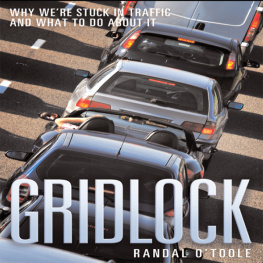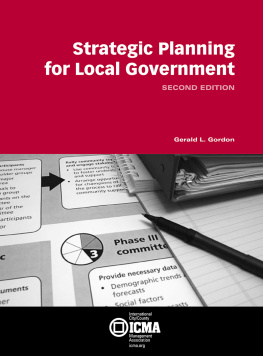Copyright 2007 by Cato Institute.
All rights reserved.
Library of Congress Cataloging-in-Publication Data
OToole, Randal
Best-laid plans : how government planning harms your quality of life, your pocketbook, and your future / Randal OToole.
p. cm.
Includes bibliographical references and index.
ISBN 978-1-933995-07-6 (alk. paper)
1. Central planningUnited States. 2. United StatesEconomic policy2001- 3. CapitalismUnited States. I. Cato Institute. II. Title.
HC106.83086 2007
338.973dc22
2007028280
Cover design by Jon Meyers.
Printed in the United States of America.
CATO INSTITUTE
1000 Massachusetts Ave., N.W.
Washington, D.C. 20001
www.cato.org

Acknowledgments
This book should not be necessary. There are already many good books about why government planning does not work. Yet despite books such as Friedrich Hayeks 1944 The Road to Serfdom and James Scotts more recent Seeing Like a State, federal, state, and local governments continue to plan. So it is time to say, once again, that the emperor of planning has no clothes.
While the storys outline may be familiar to some, I hope the details in this book will be fresh. My education in planning comes from three decades of often-painful experiences with land-use and transportation planners. I hope that some of this books readers will be able to learn through my experiences rather than having to repeat the process.
Writers such as Hayek, Ludwig von Mises, and Milton Friedman are little more than mythological characters to me. Instead, I am especially grateful to my real mentors: Ed Whitelaw, who taught me the value of economics in studying urban problems; and John Baden and his colleagues in Bozeman, Montana, who provided a framework that helped me interpret the information I gathered when studying the Forest Service and other government agencies.
I am grateful to Stephen Town, who did much of the research contained in the chapter on smart growth and crime, and Kathleen Calongne and Michael Cunneen, who did a considerable amount of the research that went into chapter 31. Kathleen also sacrificed much of her time both in reviewing a draft of this book and in assisting me with some of the other projects described in it. Peter Van Doren of the Cato Institute also made many helpful comments on the draft. Finally, I would like to thank my partner Vickie Crowley for supporting all the efforts that went into this book and for being my most faithful critic. Of course, I take full responsibility for any errors in the book.
Introduction
In proving foresight may be vain;
The best-laid schemes o mice an men
Gang aft agley,
An leae us nought but grief an pain,
For promisd joy!
Robert Burns
Somewhere in the United States today, government officials are writing a plan that will profoundly affect other peoples lives, incomes, and property. Though it may be written with the best intentions, the plan will go horribly wrong. The costs will be far higher than anticipated, the benefits will prove far smaller, and various unintended consequences will turn out to be worse than even the plans critics predicted.
People might blame the plans failure on the officials who wrote it, who may lose their jobs or be voted out of office. More likely, officials and planners will shift the blame to outside circumstances. Who could have known that costs would rise? That new technologies would render the plan useless or pointless? Or that people wouldnt behave in the ways planners expected? Even more likely, few members of the public will even notice that the plan failed because few will remember what the plan said or that it was written at all. Instead, increased traffic congestion, unaffordable housing, declining employment, or other consequences of the plan will be considered just one of those things.
Few will blame any of these problems on the concept of government planning itself. Government planning has become an accepted part of life in these United States. Almost every city and county in the nation has a planning department and many states have laws requiring cities and counties to plan. Running government without planners seems almost as foreign as running marathons without air to breathe.
Yet government planning almost always leads to disaster because government planning is simply not possible. As part two of this book will reveal, the task is too big for anyone to understand and the planning process is too slow to keep up with the realities of modern life. Part four will show that most of the professionals who call themselves planners are poorly trained to do the work they set out to do. Even if scientific planning were possible and the right people were doing it, part six will show that politics inevitably distort the results into something totally irrational.
Fifteen years ago, Americans cheered the victory of free markets over the centralized planning that failed so miserably in the Soviet Union and Eastern Europe. Yet we have already forgotten these stark lessons about the impracticality of government planning. Even as government officials in Poland, Hungary, and the Czech Republic were trying to figure out how to restore free markets to their once-planned economies, planners in the United States were seeking greater influence over land use, transportation, health care, energy, and other aspects of our economy. As Boris Yeltsin faced down the tanks of an attempted coup in 1991, the U.S. Congress was passing a law that gave planners more control than ever over our cities and the people who live in them.1
Today, the negative consequences of that law and planning in general can be felt in housing bubbles, increased traffic congestion, growing restrictions on what people are allowed to do with their property, and declining employment in some urban areas that should be rapidly growing. Yet planners manage to blame congestion on people who drive alone instead of taking transit; unaffordable housing on speculators and low interest rates; and unemployment on greedy corporations outsourcing to other parts of the world. Few place the real blame where it belongs: in the laps of planners who deliberately created the congestion, cheerfully drove up housing prices, and eagerly wrote regulations hostile to local businesses.
Everybody plans. You plan your day, your vacation, your education, and your career. Companies plan their product releases and long-term strategies. But the planning that is the subject of this book is government planning, that is, government officials and planners making decisions about your life, your property, and your future.
I want to further distinguish between broad-based government planning and mission planning. Government agencies whose missions are both clear and narrowly defined need to organize their resources to carry out those missions, and such organization might be called planning. Such flexible, short-term mission planning is a necessary part of any organization. Instead, as used here, government planning refers to three kinds of planning:
Comprehensive planning that attempts to deal with both quantifiable (but not always comparable) values, such as dollars, recreation days, or transit trips, and qualitative values, such as a sense of community. The noncomparable and qualitative nature of comprehensive planning allows or even forces planners and special interest groups to put their own preferences ahead of what the public wants or needs. Part one of this book will show how the U.S. Forest Service spent more than a billion dollars comprehensively planning the national forests and ended up with plans that were obsolete before they were published because political, social, and scientific realities changed faster than the planners could write.














